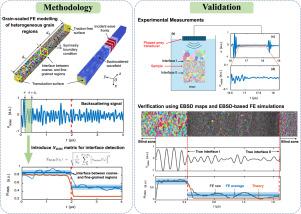Ultrasonic backscattering method for characterizing the non-uniform microstructure of polycrystals
IF 9.4
1区 工程技术
Q1 ENGINEERING, MECHANICAL
International Journal of Mechanical Sciences
Pub Date : 2025-09-18
DOI:10.1016/j.ijmecsci.2025.110831
引用次数: 0
Abstract
The characterization of polycrystalline microstructure is crucial for understanding and optimizing mechanical properties. Although ultrasonic backscattering has proven effective for uniform grain structures, it remains challenging to apply to non-uniform, multilayered grain distributions. In this paper, we present a novel ultrasonic backscattering method tailored to such heterogeneous microstructures. We develop a theoretical model to describe backscattering in such materials and propose a feature quantity, , to capture time-domain amplitude changes caused by microstructure transitions. The approach is first validated on synthetic layered polycrystals, where 3D grain-scale finite element (FE) simulations confirm excellent agreement with theoretical predictions. A subsequent 2D FE parametric study demonstrates robust detection of interfaces between regions of differing grain sizes for various interface depths and grain-size ratios. We further corroborate the method’s effectiveness through experiments on a welded sample and detailed FE simulations based on the electron backscatter diffraction data. Collectively, these results highlight the capability of ultrasonic backscattering for non-destructive evaluation of complex polycrystalline structures, especially in industrial applications that require rapid assessment of grain size variations (e.g. welded joints or additively manufactured metal parts).

表征多晶非均匀微观结构的超声后向散射方法
多晶微观结构的表征是理解和优化力学性能的关键。虽然超声后向散射已被证明对均匀晶粒结构是有效的,但将其应用于非均匀的多层晶粒分布仍然具有挑战性。在本文中,我们提出了一种针对这种非均质微结构的新型超声后向散射方法。我们建立了一个理论模型来描述这种材料中的后向散射,并提出了一个特征量NRMS来捕捉微观结构转变引起的时域振幅变化。该方法首先在合成层状多晶体上进行了验证,其中三维晶粒尺度有限元(FE)模拟证实了与理论预测的良好一致性。随后的二维有限元参数研究表明,在不同的界面深度和粒度比下,不同粒度区域之间的界面具有鲁棒性。通过焊接样品的实验和基于电子背散射衍射数据的详细有限元模拟,进一步证实了该方法的有效性。总的来说,这些结果突出了超声后向散射对复杂多晶结构无损评估的能力,特别是在需要快速评估晶粒尺寸变化的工业应用中(例如焊接接头或增材制造的金属部件)。
本文章由计算机程序翻译,如有差异,请以英文原文为准。
求助全文
约1分钟内获得全文
求助全文
来源期刊

International Journal of Mechanical Sciences
工程技术-工程:机械
CiteScore
12.80
自引率
17.80%
发文量
769
审稿时长
19 days
期刊介绍:
The International Journal of Mechanical Sciences (IJMS) serves as a global platform for the publication and dissemination of original research that contributes to a deeper scientific understanding of the fundamental disciplines within mechanical, civil, and material engineering.
The primary focus of IJMS is to showcase innovative and ground-breaking work that utilizes analytical and computational modeling techniques, such as Finite Element Method (FEM), Boundary Element Method (BEM), and mesh-free methods, among others. These modeling methods are applied to diverse fields including rigid-body mechanics (e.g., dynamics, vibration, stability), structural mechanics, metal forming, advanced materials (e.g., metals, composites, cellular, smart) behavior and applications, impact mechanics, strain localization, and other nonlinear effects (e.g., large deflections, plasticity, fracture).
Additionally, IJMS covers the realms of fluid mechanics (both external and internal flows), tribology, thermodynamics, and materials processing. These subjects collectively form the core of the journal's content.
In summary, IJMS provides a prestigious platform for researchers to present their original contributions, shedding light on analytical and computational modeling methods in various areas of mechanical engineering, as well as exploring the behavior and application of advanced materials, fluid mechanics, thermodynamics, and materials processing.
 求助内容:
求助内容: 应助结果提醒方式:
应助结果提醒方式:


